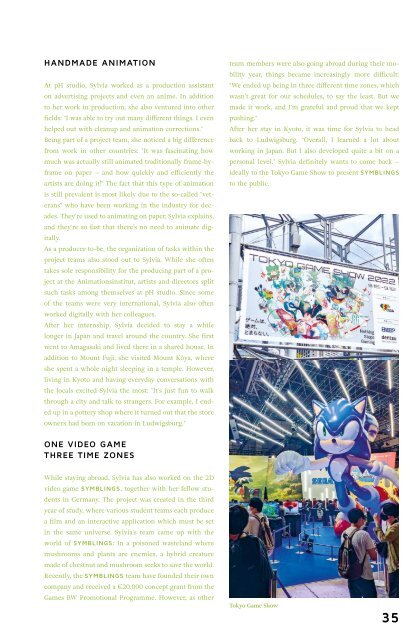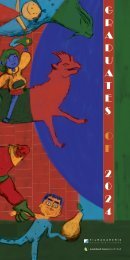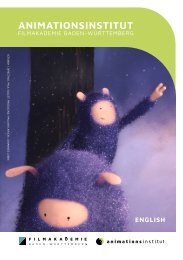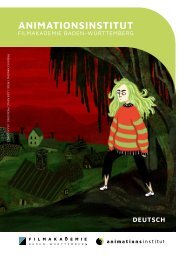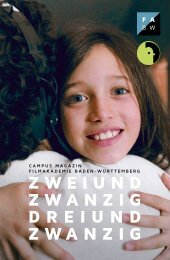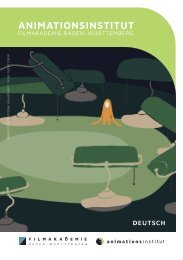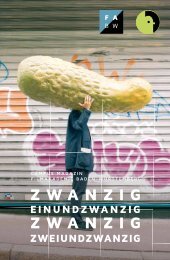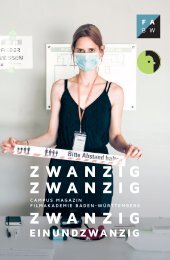Filmakademie Baden-Württemberg Campus Magazin 23/24
Sie wollen auch ein ePaper? Erhöhen Sie die Reichweite Ihrer Titel.
YUMPU macht aus Druck-PDFs automatisch weboptimierte ePaper, die Google liebt.
HANDMADE ANIMATION<br />
At pH studio, Sylvia worked as a production assistant<br />
on advertising projects and even an anime. In addition<br />
to her work in production, she also ventured into other<br />
fields: "I was able to try out many different things. I even<br />
helped out with cleanup and animation corrections."<br />
Being part of a project team, she noticed a big difference<br />
from work in other countries: "It was fascinating how<br />
much was actually still animated traditionally frame-byframe<br />
on paper – and how quickly and efficiently the<br />
artists are doing it!" The fact that this type of animation<br />
is still prevalent is most likely due to the so-called "veterans"<br />
who have been working in the industry for decades.<br />
They're used to animating on paper, Sylvia explains,<br />
and they're so fast that there’s no need to animate digitally.<br />
As a producer to-be, the organization of tasks within the<br />
project teams also stood out to Sylvia. While she often<br />
takes sole responsibility for the producing part of a project<br />
at the Animationsinstitut, artists and directors split<br />
such tasks among themselves at pH studio. Since some<br />
of the teams were very international, Sylvia also often<br />
worked digitally with her colleagues.<br />
After her internship, Sylvia decided to stay a while<br />
longer in Japan and travel around the country. She first<br />
went to Amagasaki and lived there in a shared house. In<br />
addition to Mount Fuji, she visited Mount Kōya, where<br />
she spent a whole night sleeping in a temple. However,<br />
living in Kyoto and having everyday conversations with<br />
the locals excited Sylvia the most: "It's just fun to walk<br />
through a city and talk to strangers. For example, I ended<br />
up in a pottery shop where it turned out that the store<br />
owners had been on vacation in Ludwigsburg."<br />
team members were also going abroad during their mobility<br />
year, things became increasingly more difficult:<br />
"We ended up being in three different time zones, which<br />
wasn’t great for our schedules, to say the least. But we<br />
made it work, and I'm grateful and proud that we kept<br />
pushing."<br />
After her stay in Kyoto, it was time for Sylvia to head<br />
back to Ludwigsburg. "Overall, I learned a lot about<br />
working in Japan. But I also developed quite a bit on a<br />
personal level." Sylvia definitely wants to come back –<br />
ideally to the Tokyo Game Show to present SYMBLINGS<br />
to the public.<br />
ONE VIDEO GAME<br />
THREE TIME ZONES<br />
While staying abroad, Sylvia has also worked on the 2D<br />
video game SYMBLINGS, together with her fellow students<br />
in Germany. The project was created in the third<br />
year of study, where various student teams each produce<br />
a film and an interactive application which must be set<br />
in the same universe. Sylvia's team came up with the<br />
world of SYMBLINGS: In a poisoned wasteland where<br />
mushrooms and plants are enemies, a hybrid creature<br />
made of chestnut and mushroom seeks to save the world.<br />
Recently, the SYMBLINGS team have founded their own<br />
company and received a €20,000 concept grant from the<br />
Games BW Promotional Programme. However, as other<br />
Tokyo Game Show<br />
35


